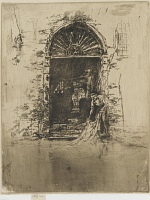Etchings Institutions search term: caxton club
The Dyer | ||
| Number: | 192 | |
| Date: | 1879/1880 | |
| Medium: | etching and drypoint | |
| Size: | 306 x 240 mm | |
| Signed: | butterfly at left | |
| Inscribed: | no | |
| Set/Publication: | no | |
| No. of States: | 10 | |
| Known impressions: | 18 | |
| Catalogues: | K.219; M.216; W.189 | |
| Impressions taken from this plate (18) | ||
PUBLICATION
EXHIBITIONS
8: London FAS 1883 (cat. no. 11).
9: 'Mr Whistler's Venice', St James Gazette, 9 December 1880 (GUL PC15/13).
10: Anon., 'Mr Whistler's Etchings', Daily News, 20 February 1883 (GUL PC25/20).
11: Anon., 'Mr Whistler's Etchings', Globe, 19 February 1883 (GUL PC 25/19).
 ). 12 Another impression was lent by Mansfield's chief competitor as collector of Whistler's etchings, Charles Lang Freer (1856-1919), to an exhibition in Detroit in 1889 and to one organised by the Caxton Club in Chicago in 1900 (
). 12 Another impression was lent by Mansfield's chief competitor as collector of Whistler's etchings, Charles Lang Freer (1856-1919), to an exhibition in Detroit in 1889 and to one organised by the Caxton Club in Chicago in 1900 ( ). 13 Impressions were later shown at the Pan-American Exposition in Buffalo in 1901 and by H. Wunderlich & Co. in New York in 1903. 14
). 13 Impressions were later shown at the Pan-American Exposition in Buffalo in 1901 and by H. Wunderlich & Co. in New York in 1903. 14
After Whistler's death two impressions, of different states, were shown at the Grolier Club in New York in 1904, and individual impressions at the Memorial shows in Paris and London in 1905. 15
12: Chicago 1893 (cat. no. 2237 [1669]); Philadelphia 1902 (cat. no. 947 [187] ); Boston 1904 (cat. no. 147).
13: Detroit Museum of Art, Paintings, Water Colors, Drawings Etchings..., 1889 (cat. no. 201); Chicago 1900 (cat. no. 169).
14: See REFERENCES : EXHIBITIONS.
15: New York 1904a (cat. nos. 191, 191b); London Mem. 1905 (cat. no. 189).
SALES & COLLECTORS
Several richly inked impressions were signed by Whistler for sale about 1886 or 1887 (
 ,
,  ,
,  ,
,  ). On 31 January 1887 Ernest George Brown (1853/1854-1915) asked Whistler: 'Have you any proofs of "The Dyer"? I have an application from a man in the trade in America. If you have, how much would they cost us?' It is likely that Whistler provided the Fine Art Society with an impression in response, and also sold one to Messrs Dowdeswell, who likewise asked for impressions. 18 The 'man in the trade in America' may have been Edward Guthrie Kennedy (1849-1932), who wrote on 4 February 1888 to Whistler, 'have you ever done anything to the plate of "The Dyer"?' 19 Whistler's son responded: 'As yet he has not since thought of "The Dyer" - but now that it is brought to his notice he will look at it - and if any thing comes of it you shall hear.' 20 Later in the year Hermann Wunderlich (ca 1839- d.1892) reiterated their interest in the plate: 'send 3 proofs of the Dyer if you have printed the plate again -
' 21 At some point Whistler must have complied, not necessarily by printing new impressions, but taking early ones from the stock in his studio, for Charles Lang Freer (1856-1919) bought an early (ca 1880) impression from H. Wunderlich & Co. on 25 October 1888 (
). On 31 January 1887 Ernest George Brown (1853/1854-1915) asked Whistler: 'Have you any proofs of "The Dyer"? I have an application from a man in the trade in America. If you have, how much would they cost us?' It is likely that Whistler provided the Fine Art Society with an impression in response, and also sold one to Messrs Dowdeswell, who likewise asked for impressions. 18 The 'man in the trade in America' may have been Edward Guthrie Kennedy (1849-1932), who wrote on 4 February 1888 to Whistler, 'have you ever done anything to the plate of "The Dyer"?' 19 Whistler's son responded: 'As yet he has not since thought of "The Dyer" - but now that it is brought to his notice he will look at it - and if any thing comes of it you shall hear.' 20 Later in the year Hermann Wunderlich (ca 1839- d.1892) reiterated their interest in the plate: 'send 3 proofs of the Dyer if you have printed the plate again -
' 21 At some point Whistler must have complied, not necessarily by printing new impressions, but taking early ones from the stock in his studio, for Charles Lang Freer (1856-1919) bought an early (ca 1880) impression from H. Wunderlich & Co. on 25 October 1888 ( ).
). ,
,  ) and a counterproof (
) and a counterproof ( ), which were in the studio at his death. These were bequeathed to Rosalind Birnie Philip (1873-1958) who gave and bequeathed them to the University of Glasgow.
), which were in the studio at his death. These were bequeathed to Rosalind Birnie Philip (1873-1958) who gave and bequeathed them to the University of Glasgow.Other early collectors included Peter Arrell Brown Widener (1834-1915) (
 ); Mrs W. B. Cutting (m. 1877) (
); Mrs W. B. Cutting (m. 1877) ( ); Harry Brisbane Dick (1855-1916) (
); Harry Brisbane Dick (1855-1916) ( ); John L. Severance (1863-1936) (
); John L. Severance (1863-1936) ( ); Edward James (dates unknown) (
); Edward James (dates unknown) ( ); Ralph King (1855-1926) and his wife (
); Ralph King (1855-1926) and his wife ( ); and Pauline Kohlsaat Palmer (1882-1956) (
); and Pauline Kohlsaat Palmer (1882-1956) ( ).
).22: 18 April 1893, GUW #01259.
